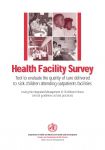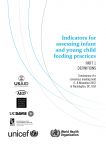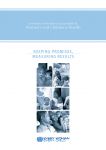Child health indicators
IMCI health facility indicators
 Priority indicators and supplemental measures on both health worker’s skills and health system supports for IMCI (Integrated management of childhood illness) at primary health care facility level are included in Annex D and E, respectively, of the WHO manual on the IMCI health facility survey:
Priority indicators and supplemental measures on both health worker’s skills and health system supports for IMCI (Integrated management of childhood illness) at primary health care facility level are included in Annex D and E, respectively, of the WHO manual on the IMCI health facility survey:
Indicators for assessing infant and young child feeding practices
 Indicators for assessing infant and young child feeding practices include 8 core indicators and 7 optional indicators, are population-based and can be derived from household survey data.
Indicators for assessing infant and young child feeding practices include 8 core indicators and 7 optional indicators, are population-based and can be derived from household survey data.
The indicators are the result of a consensus meeting held in Washington DC, USA, 6-8 November 2007. Developments in knowledge and recommendations in this area prompted the revision and expansion of the indicators which had been developed earlier for breastfeeding (1991) and for complementary feeding (2002).
Indicators for care for child development
 A set of indicators for care for child development has been developed to assess the status and quality of implementation of the intervention - including inputs, health providers’ performance and caregivers’ practices, and its impact.
A set of indicators for care for child development has been developed to assess the status and quality of implementation of the intervention - including inputs, health providers’ performance and caregivers’ practices, and its impact.
“Countdown to 2015” indicators and profiles
 The “Countdown to 2015” initiative collects indicators on key maternal, neonatal and child interventions to reduce maternal and child mortality, in line with the related Millennium Development Goals, in 75 countries which represent 95% of all maternal, neonatal and child mortality.
The “Countdown to 2015” initiative collects indicators on key maternal, neonatal and child interventions to reduce maternal and child mortality, in line with the related Millennium Development Goals, in 75 countries which represent 95% of all maternal, neonatal and child mortality.
Impact and coverage indicators across the continuum of care are presented in graphs as country profiles.
Core indicators by the Commission on information and accountability for Women’s and Children’s Health
 The Commission, in its report “Keeping promises, measuring results”, has selected a core of 11 indicators on maternal, neonatal and child health, aligned with the indicators of the Millennium Development Goals and with the continuum of care for maternal, newborn, and child health.
The Commission, in its report “Keeping promises, measuring results”, has selected a core of 11 indicators on maternal, neonatal and child health, aligned with the indicators of the Millennium Development Goals and with the continuum of care for maternal, newborn, and child health.
The indicators include three impact indicators and eight coverage indicators.
Impact indicators on the health status of women’s and children’s health.
- Maternal mortality ratio (deaths per 100 000 live births);
- Underfive child mortality, with the proportion of newborn deaths (deaths per 1000 live births);
- Children under five who are stunted (percentage of children under five years of age whose height-for-age is below minus two standard deviations from the median of the WHO Child Growth Standards).
Coverage indicators on key interventions on women’s and children’s health.
- Met need for contraception (proportion of women aged 15-49 years who are married or in union and who have met their need for family planning, i.e. who do not want any more children or want to wait at least two years before having a baby, and are using contraception);
- Antenatal care coverage (percentage of women aged 15–49 with a live birth who received antenatal care by a skilled health provider at least four times during pregnancy);
- Antiretroviral prophylaxis among HIV-positive pregnant women to prevent vertical transmission of HIV, and antiretroviral therapy for women who are treatment-eligible;
- Skilled attendant at birth (percentage of live births attended by skilled health personnel);
- Postnatal care for mothers and babies (percentage of mothers and babies who received postnatal care visit within two days of childbirth);
- Exclusive breastfeeding for six months (percentage of infants aged 0–5 months who are exclusively breastfed);
- Three doses of the combined diphtheria, pertussis and tetanus vaccine (percentage of infants aged 12–23 months who received three doses of diphtheria/pertussis/tetanus vaccine);
- Antibiotic treatment for pneumonia (percentage of children aged 0–59 months with suspected pneumonia receiving antibiotics).








